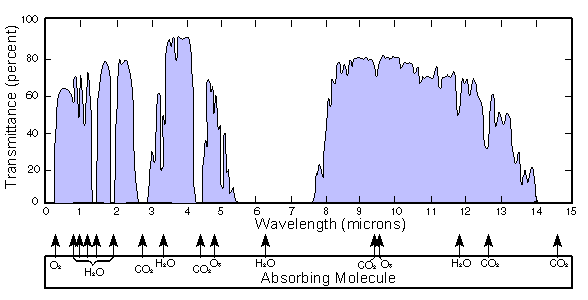
J band
Encyclopedia
J band can refer to two different regions of the electromagnetic spectrum, in the radio and near-infrared.
from 10 GHz
to 20 GHz in the electromagnetic spectrum
. This is equal to wave lengths between 3 and 1.5 cm (1.2 and 0.590551181102362 ). The J band is in the SHF
range of the radio spectrum
.
The I band intersects with the X band
and K band
of the older classification system. The Ku band
is within the J band.
in the United Kingdom
, the term "J Band" is also used by the Joint Radio Company to refer to their VHF communications band at 139.5-140.5 and 148-149 MHz used by fuel and power industries.
 In infrared astronomy
In infrared astronomy
, the J band refers to an atmospheric transmission window centred on 1.25 micrometres (in the near-infrared). Betelgeuse
is the brightest near-IR source in the sky with a J band magnitude
of -2.99.
, the latter being central to aircraft systems and their avionics. Satellite communications systems can be used in conjunction with aircraft to help locate and identify enemy targets or provide a role as a reconnaissance platform for soldiers on the ground.
Radio
The J band is the range of radio frequenciesRadio frequency
Radio frequency is a rate of oscillation in the range of about 3 kHz to 300 GHz, which corresponds to the frequency of radio waves, and the alternating currents which carry radio signals...
from 10 GHz
Hertz
The hertz is the SI unit of frequency defined as the number of cycles per second of a periodic phenomenon. One of its most common uses is the description of the sine wave, particularly those used in radio and audio applications....
to 20 GHz in the electromagnetic spectrum
Electromagnetic spectrum
The electromagnetic spectrum is the range of all possible frequencies of electromagnetic radiation. The "electromagnetic spectrum" of an object is the characteristic distribution of electromagnetic radiation emitted or absorbed by that particular object....
. This is equal to wave lengths between 3 and 1.5 cm (1.2 and 0.590551181102362 ). The J band is in the SHF
Super high frequency
Super high frequency refers to radio frequencies in the range of 3 GHz and 30 GHz. This band of frequencies is also known as the centimetre band or centimetre wave as the wavelengths range from ten to one centimetres....
range of the radio spectrum
Radio spectrum
Radio spectrum refers to the part of the electromagnetic spectrum corresponding to radio frequencies – that is, frequencies lower than around 300 GHz ....
.
The I band intersects with the X band
X band
The X band is a segment of the microwave radio region of the electromagnetic spectrum. In some cases, such as in communication engineering, the frequency range of X band is rather indefinitely set at approximately 7.0 to 11.2 gigahertz . In radar engineering, the frequency range is specified...
and K band
K band
K band designates certain portions of the electromagnetic spectrum, in either the microwave domain or in the infrared domain. The microwave K bands are used primarily for radar and satellite communications while the infrared K band is used for astronomical observations.-NATO K band:The NATO K band...
of the older classification system. The Ku band
Ku band
The Kμ band is a portion of the electromagnetic spectrum in the microwave range of frequencies. This symbol refers to —in other words, the band directly below the K-band...
is within the J band.
in the United Kingdom
United Kingdom
The United Kingdom of Great Britain and Northern IrelandIn the United Kingdom and Dependencies, other languages have been officially recognised as legitimate autochthonous languages under the European Charter for Regional or Minority Languages...
, the term "J Band" is also used by the Joint Radio Company to refer to their VHF communications band at 139.5-140.5 and 148-149 MHz used by fuel and power industries.
Infrared astronomy

Infrared astronomy
Infrared astronomy is the branch of astronomy and astrophysics that studies astronomical objects visible in infrared radiation. The wavelength of infrared light ranges from 0.75 to 300 micrometers...
, the J band refers to an atmospheric transmission window centred on 1.25 micrometres (in the near-infrared). Betelgeuse
Betelgeuse
Betelgeuse, also known by its Bayer designation Alpha Orionis , is the eighth brightest star in the night sky and second brightest star in the constellation of Orion, outshining its neighbour Rigel only rarely...
is the brightest near-IR source in the sky with a J band magnitude
Magnitude (astronomy)
Magnitude is the logarithmic measure of the brightness of an object, in astronomy, measured in a specific wavelength or passband, usually in optical or near-infrared wavelengths.-Background:...
of -2.99.
Uses
The J band is used for satellite communications and radarRadar
Radar is an object-detection system which uses radio waves to determine the range, altitude, direction, or speed of objects. It can be used to detect aircraft, ships, spacecraft, guided missiles, motor vehicles, weather formations, and terrain. The radar dish or antenna transmits pulses of radio...
, the latter being central to aircraft systems and their avionics. Satellite communications systems can be used in conjunction with aircraft to help locate and identify enemy targets or provide a role as a reconnaissance platform for soldiers on the ground.

